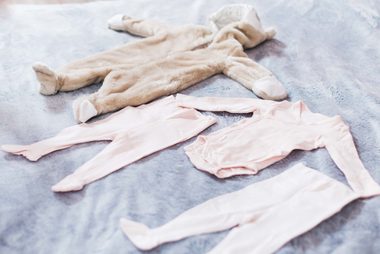
Limit the options
Most children that struggle with choosing clothes to wear are actually kids that are sensitive to the clothing itself. Whether it be texture, color, or the way it fits, clothing can elicit all kinds of responses from children, and most often they’re negative. Avoiding a sense of overwhelm is often the safest bet to stop a battle before it begins, suggests Barbara Greenberg, PhD, a clinical psychologist specializing in parenting and teens, as well as co-author of Teenage as a Second Language. “When you give kids too many choices, especially those that are sensitive in some way to begin with, it makes the entire process more stressful for both parent and child,” she tells Reader’s Digest. Dr. Greenberg suggests giving a child two outfit options to choose from, making the decision much easier for the child, and avoiding a circumstance in which the child loses focus and becomes frustrated.

Buy approved items only
When shopping with your child, it can be tempting to try and steer your child toward clothing pieces that you would choose rather than what your child prefers. However, it’s important to find items that you both can agree on, so that your child’s closet is filled with only those items. Dr. Greenberg urges parents to have their children try on the clothing at the store first, explaining, “Many kids are sensitive to texture, so it’s vital that they feel the clothing against their skin before making a decision.” She continues, “Sometimes they will love an item that feels or looks soft on the outside, but is actually rough or scratchy on the interior, and this can be frustrating for the child when they love a piece on the hanger, but don’t enjoy actually wearing it. Making sure they are comfortable in the clothing before it’s time to wear it out of the house can cut down on a lot of frustration and tears.”

Give the gift of patience
While it’s difficult in the five minutes before the school bus arrives to take a step back and assess how serious a wardrobe catastrophe really is, your relationship with your child will only benefit if you can do just that. “These children will appreciate your patience and understanding,” says Dr. Greenberg. “They aren’t trying to be bad or defiant, they are simply feeling sensitive to certain things. Time and patience are both things we can give our children, and they’ll be grateful for it in the end,” she continued. If you find yourself getting worked up over your child’s lack of decision or contentment with his or her clothing options, try saying something that validates their feelings, such as, “I know you’re feeling really frustrated right now, and nothing feels like a good choice. Let’s try to pick something you can feel comfortable in for today, and when you get home we can talk about what to do for tomorrow.”

Keep the receipts
Every parent knows that even for themselves, an outfit might look or feel great at the store, but at home it’s a different story. Keep those receipts and tags on the clothing, suggests Dr. Greenberg. “If they go to school and realize no one else is wearing what they just purchased, it can change the way they feel about it entirely,” she says. She continues,”Giving your child the option to return something can save you both a lot of tears and guilt. We can all remember a time when a fashion choice we made wasn’t in line with our peers, can’t we?” Not only will allowing your child to change his or her mind without added guilt strengthen the trust they have in you, it also provides an opportunity to talk about peer pressure and individual expression of identity. Here’s what to do when your child is the bully.

Make shopping fun
Shopping with your child for clothing can feel like a burden, but only if you make it that way. Dr. Greenberg suggests putting a positive spin on shopping excursions, saying, “Learn what it is your child likes and look at it as a treasure hunt. Turning shopping into a fun experience based on their unique preferences can make all the difference.” Prior to a shopping excursion have a conversation with your child about their preferences, and use those to compile a list to “hunt” for. Do they like shorts or prefer skirts? Are they more comfortable in lightweight cardigans or bulky sweaters? Knowing what your child hopes to find on the outing can be half the battle when helping your child shop for clothes they’ll actually wear. Here are 13 outfit tricks to fake longer legs.

Prepare in advance
Procrastination has no place when it comes to getting fussy children dressed in the morning. Not only are most children hard to wake for school, the time when they are still waking up and groggy can be fraught with opportunity for melt downs and frustration. Try to lay out the outfit your child will wear the following day before going to bed the night before. Dr. Greenberg suggests that not only should parents have the outfit out and chosen, but they should also make sure any choices between outfits take place the night before. “Make sure that they’ve already narrowed their choice to one outfit prior to waking in the morning. It saves you both a lot of stress and frustration, and starts the morning off on a more peaceful note,” she suggests. Having your child choose any accessories or shoes to go with an ensemble can further simplify busy mornings when tensions run high. Find out the morning habits of highly successful people.

Keep your emotions in check
Most parents are all too familiar with their own rising tempers when their child cannot seem to make a decision, or flat-out refuses to wear an outfit they previously loved. Although it’s tempting to let your own emotions take control, resist the temptation at all costs, suggests Dr. Greenberg. “If you get emotional about an outfit, your negative emotion then becomes associated with it, and the child won’t ever want to wear it,” she explained. “It then becomes the sweater or shirt that Mom yelled at them in, and they remember the argument every time they see the item,” she continues. Instead of letting your own temper get the best of you, try to give them as much patience as you can muster at the moment and remain calm.

Dress them in layers
Little acts of kindness can go a long way in making your child feel loved and supported throughout the day. One way to lessen frustrations with clothing is to empower your child to make themselves more comfortable. “If you dress a child in layers, you are actually giving them a little control to make themselves more comfortable,” Dr. Greenberg says. “You can also pack their favorite sweatshirt or another pair of shoes in their bag, so they know that not only are you thinking of them, but that they have options. It means a lot to kids to know they can make some choices for themselves,” she explained. Here are ten tips all tights wearers must know.

Have empathy
Before reprimanding your child about their inability to dress themselves without drama, consider your own history. Can you remember a time when you felt like nothing fit or felt right, and the task of finding something to wear felt overwhelming? This is the time to give your child a good dose of empathy, says Dr. Greenberg. “Parents need to consider how they choose their own clothing. As an adult, you pick what makes you feel great—we all want to feel like we are wearing the clothes and the clothes aren’t wearing us,” she explains. The next time you sense your child growing frustrated, offering an empathetic remark such as, “It’s so frustrating when I can’t find something to wear. I totally understand,” can ease tensions enough to find your way to a peaceful solution.

Make the closet a guilt-free zone
“Aunt Martha gave that sweater to you last Christmas—you owe it to her to wear it once,” or, “Do you know how much I paid for those jeans?” Sound familiar? It’s incredibly tempting to guilt your child into wearing a gift from someone special, or reminding them of the money spent on an item, but Dr. Greenberg says this isn’t an effective way to handle wardrobe related arguments. “Instead of using guilt to persuade your child to wear something, turn their negative response into a guilt-free positive solution by suggesting that you donate the unwanted clothing,” she says. Dr. Greenberg adds, “You should encourage your child to be grateful for the gift and show gratitude, but just because someone bought a gift for you doesn’t require you to like it. There’s enough adverse experiences in this world, we don’t need to add guilt to them.”

Accept them as they are
Your child is looking for far more than the perfect pair of jeans or the latest stylish shoe. What your child is really hoping to find is your unconditional love and acceptance. Your child needs to know that no matter what they wear (or don’t) they are loved and accepted as they are. Dr. Greenberg is quick to point out to parents that some kids are simply more sensitive than others, saying, “There’s nothing wrong with a child that is sensitive to their clothing choices, or feels frustrated when choosing clothing to wear. This is simply who they are—they may be sensitive to texture, color, or feel—whatever it is, it’s who they are, and they want your acceptance for it.”
